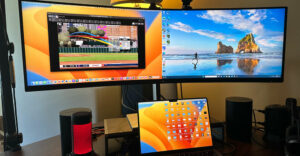Telly, a company started by Pluto TV co-founder Ilya Pozin, on Monday announced it’s offering 500,000 55-inch 4K TVs free to the public as part of a business model that has advertisers pick up the tab for a consumer’s entertainment upgrade.
At the center of the model, which has been in the works for two years, is a dual-screen smart TV developed by Telly. One screen is a 55-inch 4K HDR Home Theater Television Display divided from a smaller smart screen by a five-driver sound bar. The smart screen displays information, such as news, sports scores, and weather, as well as advertising, which is continuously displayed in a dedicated area on the right side of the smart screen.
In addition to TV programming, the hardware supports video calling, video games, an AI-enabled voice assistant, music services, and motion-tracking fitness programs.
“Telly is the biggest innovation in television since color,” Pozin boasted in a statement. “Telly is a revolutionary step forward for both consumers and advertisers.”
“For too long,” he continued. “Consumers have not been an equal part of the advertising value exchange. Companies are making billions of dollars from ads served on televisions, yet consumers have historically had to pay for both the TV and the content they watch.”
“All of that changes today,” he added. “When I co-founded Pluto TV, we created an entirely new model that offered amazing TV content to viewers for free. Now, with Telly, we are providing the actual television for free as well.”
Consumer Tradeoff
Telly will help streaming companies afford the content they need and want through an always-on ad experience, observed Elizabeth Parks, president and CMO of Parks Associates, a market research and consulting company specializing in consumer technology products, in Addison, Texas.
“We project that the number of households using ad-supported streaming services will grow from about 37 million households in 2022 to 52 million in 2027, a compound annual growth rate of 6.7%,” she told TechNewsWorld.
Pozin estimates that TVs with Telly’s specs and capabilities are selling for US$1,000, although 4K TVs are selling for less than that. “Telly will be interesting for households that are budget constrained but open to advertising,” noted Brett Sappington, vice president of Interpret, a global consumer insights agency.
“Currently, users can buy an entry-level 55-inch, 4k smart TV for $300 to $400,” he told TechNewsWorld. “So, users will be considering the tradeoff of an upgraded TV versus the always-on advertising.”
“Telly is one of the more intriguing attempts to address the market of users who are willing to give up their data in exchange for a free TV,” added Mark N. Vena, president and principal analyst at SmartTech Research, in San Jose, Calif.
“This could be attractive to a non-trivial number of users willing to make this commitment, as the TV is a 55-inch HDR model, which has a $600 value.”
‘Huge Leap Forward’
Richard Greenfield, general partner at LightShed Ventures, the firm that co-led Telly’s latest funding round, called Telly “a huge leap forward, leveraging the explosion of the connected TV ad market and the desire from consumers for greater control and interactivity that does not disrupt the TV viewing experience.”
“The groundbreaking dual screen design enables advertisers to completely reimagine the living room experience while providing consumers an incredible TV at the easy-to-say-yes-to price of free,” he said in a statement.

The Telly smart screen displays information such as news, sports scores, and weather updates, along with ongoing advertisements in a dedicated area on its right side. (Image Credit: Telly)
Parks added that free ad-supported content is potentially the next point of differentiation between streaming services and their hardware platform partners.
“We expect this also paves the way for a more interactive advertising experience and TV-based commerce experience,” she said. “Our data finds that 50% of U.S. internet households are concerned that t-commerce would interrupt the programs they are watching. Moving ads to a second screen may enable more t-commerce opportunities.”
Increasingly, streaming providers are tapping into interactive ads, added Ross Rubin, the principal analyst with Reticle Research, a consumer technology advisory firm, in New York City.
“They send you to a destination or let you scan a QR code to send information to your cell phone,” he told TechNewsWorld. “Telly may open up some new opportunities that weren’t mature in the past.”
Rob Enderle, president and principal analyst with the Enderle Group, an advisory services firm in Bend, Ore., cautions, however, that advertisers need to be attuned to their audience’s sensibilities. “The ads will need to be things users don’t mind seeing,” he told TechNewsWorld. “Otherwise, they are likely to get creative in finding ways not to see them.”
“People don’t like ads,” he added. “Putting them on a dedicated screen alone doesn’t fix that. You also need to focus on the ad content to see if you can come up with a format that isn’t disruptive to the content the user is watching.”
Volume Issue
Sappington pointed out that while consumers like free things, their commitment to them may not be as staunch as it is for things they pay for. “Some consumers may simply toss their Telly out if they don’t like it or grow tired of the ads,” he said. “Others may try to make a quick buck by reselling it on Facebook Marketplace or elsewhere.”
He added that giving away hardware to make money isn’t new. For example, mobile carriers have given away low-end smartphones to profit from mobile data plans.
“The key is being able to produce enough ongoing revenue to make it profitable,” he continued. “That said, an ad-supported television is certainly new. Controlling the whole screen is a powerful position, one that companies have been competing to win for many years.”
Parks agreed. “This is definitely a new model,” she said. “Ad revenues are an increasingly important part of smart TV and streaming media player manufacturers’ revenue mix, but business models have so far required device purchasing.”
Rubin recalled a company in the late 1990s called Free PC that tried to subsidize free computers with advertising along the perimeter of the computer’s display.
“The issue became volume,” he said. “They couldn’t reach a large enough audience to attract enough advertising revenue to make the business viable.”
“That’s going to be one of the biggest challenges here, too,” he continued. “The demand side won’t be an issue. There’s always plenty of folks willing to take a risk on something that’s free.”
“The question is on the supply side,” he said. “Can they make a convincing case to advertisers about the quality of their audience knowledge to attract the kind of investment they need to sustain the business model?”
Consumers can reserve a free TV on the Telly website.























































